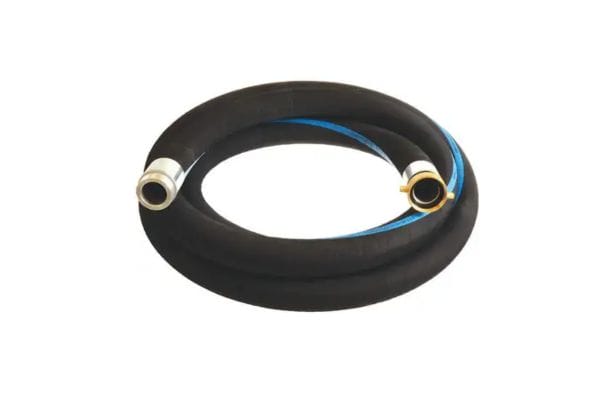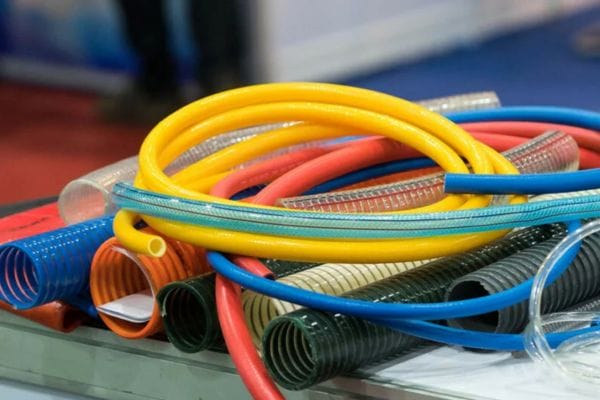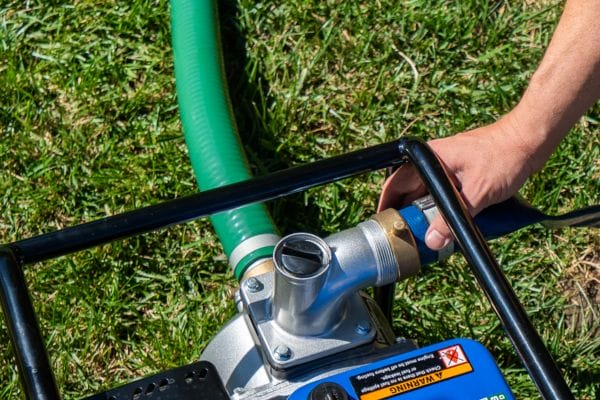While both suction and discharge hoses are used in fluid transfer, they serve distinct purposes. Suction hoses are designed to draw fluid from a source, while discharge hoses expel fluid to its destination. Knowing the differences between these hoses helps ensure that the right equipment is used for the task, preventing damage, reducing downtime, and optimizing performance.
Understanding Suction Hoses
A. What is a Suction Hose?
A suction hose is a type of hose specifically designed to draw or “suck” fluid from a source, such as a tank, reservoir, or natural body of water. It operates under negative pressure, meaning it relies on external atmospheric pressure to push the fluid into the hose as it creates a vacuum within the hose itself.
Primary Use
The primary function of a suction hose is to facilitate the movement of fluid from its source to the pump or processing system. Suction hoses are often used in systems where fluids need to be transferred over varying distances and elevations.

B. Construction and Design Features
Material Composition (e.g., Rubber, PVC)
Suction hoses are typically constructed from durable materials like rubber or PVC, designed to withstand the stress of negative pressure without collapsing. Rubber is favored for its flexibility and resistance to wear, while PVC offers a lightweight and cost-effective alternative.
Reinforcement Layers
To prevent the hose from collapsing under vacuum pressure, suction hoses are reinforced with layers of spiral wire or synthetic yarn. The spiral wire reinforcement is particularly common in heavy-duty suction hoses, providing the necessary structural integrity to maintain the hose’s shape even under significant negative pressure.
Flexibility and Durability Considerations
Flexibility is a critical feature for suction hoses, allowing them to be easily maneuvered and positioned in various operational settings. Durability is equally important, especially in harsh environments where the hose might be exposed to abrasive materials, extreme temperatures, or harsh chemicals.
C. Common Applications
Industrial, Agricultural, and Residential Uses
Suction hoses are widely used across multiple sectors, including industrial, agricultural, and residential applications. They are essential in processes that require the transfer of fluids from a lower to a higher elevation or from a remote location to a central processing point.
Specific Examples
Pumping Water from a Well: In agricultural and residential settings, suction hoses are commonly used to draw water from wells, especially in areas without direct access to municipal water supplies.
Transferring Slurries: In industrial applications, suction hoses are used to transfer slurries—mixtures of solid particles suspended in liquid—such as in mining operations or wastewater management systems. These hoses are designed to handle the abrasive nature of the slurry while maintaining a consistent flow.
D. Advantages and Limitations
Strengths
- High Flexibility: Suction hoses are designed to be highly flexible, allowing them to bend and maneuver around obstacles without kinking. This flexibility is crucial for applications where the hose needs to be routed through tight spaces or around machinery.
- Durability in Harsh Conditions: Suction hoses are built to withstand tough environmental conditions, including exposure to chemicals, UV rays, and physical abrasion. This makes them suitable for both indoor and outdoor use in demanding industrial settings.
Potential Drawbacks
- Weight: Suction hoses, particularly those reinforced with spiral wire, can be relatively heavy, making them more difficult to handle and transport compared to lighter hoses like discharge hoses.
- Handling: The rigidity required to prevent collapse under vacuum pressure can make suction hoses less flexible than other types of hoses, which may pose challenges in certain applications.
Understanding Discharge Hoses
A. What is a Discharge Hose?
A discharge hose is a type of hose designed to transport and expel fluids from a pump or other equipment to a designated discharge point. Unlike suction hoses, discharge hoses operate under positive pressure, pushing the fluid through the hose and out to its intended location.
Primary Use
The main function of a discharge hose is to direct fluid away from a pump or system after it has been drawn in, processed, or transferred. These hoses are integral in operations where fluid needs to be transported over a distance or deposited into a storage area, drainage system, or irrigation field.
B. Construction and Design Features
Material Composition (e.g., Rubber, PVC)
Discharge hoses are typically made from materials like rubber or PVC, similar to suction hoses, but with design features tailored for expelling rather than drawing fluids. Rubber discharge hoses are known for their durability and resistance to wear, while PVC hoses are valued for their lightweight nature and cost-effectiveness.
Lightweight Construction Compared to Suction Hoses
Discharge hoses are generally lighter in construction than suction hoses. This is because they don’t need the same level of reinforcement to prevent collapse under vacuum pressure. The lighter weight makes them easier to handle, especially in applications that require frequent movement or repositioning of the hose.
Reinforcement Types and Pressure Ratings
Discharge hoses may still include reinforcement, but it’s usually focused on withstanding the positive pressure from the fluid being expelled rather than resisting collapse. This reinforcement can be in the form of woven fabric layers or spiral synthetic fibers, providing the necessary strength to handle varying levels of pressure. The pressure rating of a discharge hose is a critical factor in determining its suitability for specific applications, especially in industrial settings where high pressure may be involved.

C. Common Applications
Industrial, Agricultural, and Residential Uses
Discharge hoses are used across various industries, from industrial and agricultural to residential applications. They are essential for efficiently moving fluids from one location to another, particularly when the fluid needs to be expelled from a system after use.
Specific Examples
- Draining Water from Basements: In residential settings, discharge hoses are commonly used to drain water from basements or other low-lying areas prone to flooding. These hoses are connected to sump pumps to expel water away from the property to a safer area.
- Irrigating Fields: In agricultural applications, discharge hoses are used to distribute water from pumps to irrigate fields, ensuring crops receive the necessary moisture. The hoses’ flexibility and ease of movement make them ideal for covering large areas with varying terrain.
D. Advantages and Limitations
Strengths
- Lightweight: The lightweight nature of discharge hoses makes them easier to handle, transport, and deploy, especially in situations where the hose needs to be frequently repositioned or carried over long distances.
- Easy to Maneuver: Because they are less rigid than suction hoses, discharge hoses offer greater flexibility, allowing them to be easily routed around obstacles and through tight spaces. This maneuverability is particularly beneficial in complex or confined work environments.
Potential Drawbacks
- Less Durable Under Certain Conditions: Discharge hoses, particularly those made from lighter materials like PVC, may not be as durable as suction hoses in certain conditions. They can be more susceptible to wear and tear, especially when exposed to abrasive materials or harsh environmental factors.
- Lower Pressure Tolerance: While discharge hoses are designed to handle positive pressure, their pressure tolerance is generally lower than that of suction hoses. This makes them less suitable for high-pressure applications, which could lead to hose failure if the pressure exceeds the hose’s rating.
Key Differences Between Suction and Discharge Hoses
A. Functionality
- Suction Hoses: Suction hoses are designed to pull or draw liquids from a source, such as a tank, well, or body of water. They operate under negative pressure, where the external atmospheric pressure pushes the liquid into the hose as the internal vacuum created by the pump draws the liquid up.
- Discharge Hoses: In contrast, discharge hoses are designed to push or expel liquids from a pump or other equipment to a desired location, such as a drainage system, storage tank, or irrigation field. These hoses work under positive pressure, meaning the pump forces the liquid through the hose and out to its destination.
B. Construction and Reinforcement
- Suction Hoses: Typically constructed from durable materials like rubber or PVC, suction hoses require robust reinforcement to prevent collapse under vacuum pressure. This reinforcement is often provided by spiral wire or synthetic yarn, which maintains the hose’s structural integrity even under significant negative pressure.
- Discharge Hoses: Discharge hoses are also made from materials like rubber or PVC but do not require the same level of reinforcement as suction hoses. Their construction is lighter, and the reinforcement—if present—is designed to withstand the positive pressure exerted by the fluid being expelled. This makes them more flexible and easier to handle.
Differences in Flexibility, Durability, and Resistance to Collapse
- Flexibility: Suction hoses are generally less flexible due to their reinforced structure, which is necessary to prevent collapse under vacuum conditions. Discharge hoses, being less reinforced, are more flexible and easier to maneuver, especially in applications requiring frequent repositioning.
- Durability: Suction hoses tend to be more durable, especially in harsh environments, because they need to resist not only internal vacuum pressure but also external environmental factors. Discharge hoses, while still durable, may not withstand abrasive conditions as well as suction hoses.
- Resistance to Collapse: The primary design difference lies in the suction hose’s need to resist collapse under vacuum. Discharge hoses, on the other hand, do not face this challenge and are thus constructed with less emphasis on structural rigidity.

C. Pressure Ratings and Tolerance
- Suction Hoses: These hoses are specifically engineered to handle negative pressure. Their design ensures that they can maintain structural integrity even when the internal pressure drops below atmospheric pressure, preventing collapse.
- Discharge Hoses: Discharge hoses are designed to handle positive pressure, meaning they can withstand the force exerted by the fluid being pushed through them. Their pressure tolerance varies depending on the material and construction, but they are generally not built to handle negative pressure, as this is not their intended use.
D. Application Suitability
Situations Where Suction Hoses Are Preferable
- Pumping from Depths: Suction hoses are ideal when fluids need to be drawn from deep wells, tanks, or other sources where the fluid is below the level of the pump.
- Handling Abrasive Materials: In industrial applications where abrasive materials are being transferred, the durability and resistance to collapse of suction hoses make them the better choice.
- Use in Harsh Environments: Due to their robust construction, suction hoses are preferable in harsh environments where they may be exposed to rough handling, chemicals, or extreme temperatures.
Situations Where Discharge Hoses Are Ideal
- Fluid Expulsion and Distribution: Discharge hoses are the best choice for applications where the primary need is to move fluids away from the pump to a disposal or storage site, such as draining flooded areas or irrigating fields.
- Lightweight and Maneuverable Needs: In situations where the hose needs to be frequently moved or positioned, the lighter weight and greater flexibility of discharge hoses make them more suitable.
- Short-Distance Transfers: For shorter fluid transfer distances where high pressure is not a significant concern, discharge hoses are often more convenient and cost-effective.
Choosing the Right Hose for Your Needs
A. Factors to Consider
- Fluid Type: The nature of the fluid being transferred is a critical factor. For instance, chemicals, abrasive slurries, or potable water may require hoses made from specific materials that are resistant to corrosion, abrasion, or contamination.
- Temperature: Both the fluid’s temperature and the ambient temperature can impact hose performance. High-temperature fluids may require hoses made from materials that can withstand heat without degrading, while cold environments might necessitate hoses with greater flexibility to avoid cracking.
- Environmental Conditions: Consider the environmental factors where the hose will be used, such as exposure to UV rays, chemicals, or rough handling. The hose material should be chosen based on its ability to withstand these conditions without compromising its integrity.
Pressure Requirements and Flow Rate
- Pressure Requirements: Assess the pressure requirements of your application, both in terms of suction and discharge. Suction hoses must handle negative pressure without collapsing, while discharge hoses must withstand the positive pressure exerted by the fluid being expelled. The pressure rating of the hose should exceed the maximum operating pressure of your system.
- Flow Rate: The flow rate, or the volume of fluid that must be moved within a specific timeframe, will influence the diameter and material of the hose. Higher flow rates may require larger diameter hoses or those with smooth interiors to reduce friction losses.

B. Application Scenarios
Examples of When to Choose Suction Hoses
- Well Pumping: When drawing water from a well or underground reservoir, a suction hose is necessary due to its ability to handle the negative pressure needed to lift the fluid from a lower level.
- Industrial Slurry Transfer: In industries where abrasive slurries or heavy fluids need to be moved from one point to another, the durability and reinforcement of a suction hose make it the ideal choice.
- Vacuum Tank Applications: For applications involving vacuum tanks where materials need to be drawn in under negative pressure, suction hoses are essential to ensure the fluid is properly conveyed without hose collapse.
Examples of When to Choose Discharge Hoses
- Flood Water Removal: For pumping out water from flooded areas, discharge hoses are used to expel the water away from the site. Their flexibility and lightweight construction make them easy to deploy and maneuver in these situations.
- Agricultural Irrigation: Discharge hoses are perfect for agricultural irrigation, where water needs to be distributed across large fields. Their lightweight nature allows for easy handling, and they can be quickly repositioned as needed.
- Construction Site Dewatering: On construction sites where excess water needs to be removed, discharge hoses can efficiently move water from the site to a drainage area, ensuring the site remains dry and safe for continued work.
C. Customization Options
Availability of Custom Hoses for Specialized Applications
- Custom Lengths and Diameters: Depending on the specific needs of your application, custom hose lengths and diameters can be ordered to ensure a perfect fit. This is particularly useful for large-scale operations where standard sizes may not suffice.
- Specialized Materials and Reinforcements: For applications requiring unique resistance properties, hoses can be customized with materials that resist specific chemicals, temperatures, or abrasions. Reinforcement can also be customized, such as adding additional layers or choosing a different reinforcement material to enhance durability and pressure tolerance.
Tips on Selecting the Right Materials and Reinforcements
- Material Selection: When customizing a hose, choose materials that best match the fluid type and environmental conditions. For instance, nitrile rubber might be chosen for its oil resistance, while EPDM could be selected for its ability to handle hot water and steam.
- Reinforcement Considerations: Reinforcement is key to a hose’s ability to withstand pressure and external forces. Consider spiral wire reinforcement for applications requiring high durability and resistance to collapse, or opt for textile reinforcement where flexibility and lightweight are more critical.
Conclusion
Factors such as fluid type, operating pressure, temperature, and environmental conditions all play a role in determining the suitability of a suction or discharge hose. By thoroughly evaluating these needs, you can ensure that the hose you select not only meets operational requirements but also provides durability and efficiency. If you’re not sure which hose is best suited for your application, consider consulting with Topa, where we can provide advice tailored to your unique situation. Additionally, you can take the time to learn about available product options, including customizable hoses, that can better meet the specific needs of your operation.
FAQ
What is the primary difference between suction and discharge hoses?
Suction hoses are designed to draw fluids into a system under negative pressure, while discharge hoses are used to expel fluids from a system under positive pressure.
Can I use a discharge hose for suction purposes?
No, discharge hoses are not designed to handle the negative pressure required for suction and may collapse if used in this way.
What materials are suction and discharge hoses typically made from?
Both types of hoses are commonly made from durable materials like rubber or PVC, with suction hoses often having additional reinforcement to prevent collapse.
How do I choose the right hose for my application?
Consider the type of fluid, pressure requirements, temperature, and environmental conditions. For suction needs, choose a reinforced hose, and for discharge, select a flexible hose suited to the fluid being expelled.
Are there customizable options available for suction and discharge hoses?
Yes, many suppliers offer custom lengths, diameters, and materials to meet specific application requirements.
What are common applications for suction and discharge hoses?
Suction hoses are often used in well pumping and slurry transfer, while discharge hoses are commonly used for draining water and irrigation in agriculture.





